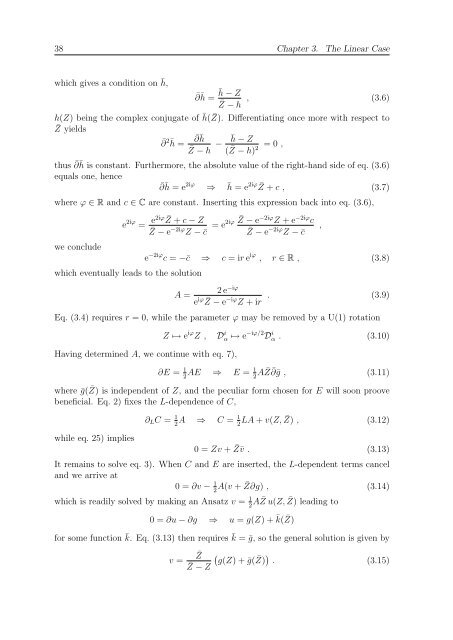N=2 Supersymmetric Gauge Theories with Nonpolynomial Interactions
N=2 Supersymmetric Gauge Theories with Nonpolynomial Interactions
N=2 Supersymmetric Gauge Theories with Nonpolynomial Interactions
You also want an ePaper? Increase the reach of your titles
YUMPU automatically turns print PDFs into web optimized ePapers that Google loves.
38 Chapter 3. The Linear Case<br />
which gives a condition on ¯ h,<br />
¯∂ ¯ h = ¯ h − Z<br />
¯Z − h<br />
, (3.6)<br />
h(Z) being the complex conjugate of ¯ h( ¯ Z). Differentiating once more <strong>with</strong> respect to<br />
¯Z yields<br />
¯∂ 2¯ ∂¯ h¯<br />
h =<br />
¯Z − h − ¯ h − Z<br />
( ¯ 2 Z − h)<br />
= 0 ,<br />
thus ¯ ∂ ¯ h is constant. Furthermore, the absolute value of the right-hand side of eq. (3.6)<br />
equals one, hence<br />
¯∂ ¯ h = e 2iϕ ⇒ ¯ h = e 2iϕ ¯ Z + c , (3.7)<br />
where ϕ ∈ R and c ∈ C are constant. Inserting this expression back into eq. (3.6),<br />
we conclude<br />
e 2iϕ = e2iϕ ¯ Z + c − Z<br />
¯Z − e −2iϕ Z − ¯c = e2iϕ ¯ Z − e −2iϕ Z + e −2iϕ c<br />
¯Z − e −2iϕ Z − ¯c<br />
which eventually leads to the solution<br />
e −2iϕ c = −¯c ⇒ c = ir e iϕ , r ∈ R , (3.8)<br />
A =<br />
2 e −iϕ<br />
e iϕ ¯ Z − e −iϕ Z + ir . (3.9)<br />
Eq. (3.4) requires r = 0, while the parameter ϕ may be removed by a U(1) rotation<br />
Having determined A, we continue <strong>with</strong> eq. 7),<br />
Z ↦→ e iϕ Z , D i α ↦→ e −iϕ/2 D i α . (3.10)<br />
∂E = 1<br />
1<br />
AE ⇒ E = 2 2A ¯ Z ¯ ∂¯g , (3.11)<br />
where ¯g( ¯ Z) is independent of Z, and the peculiar form chosen for E will soon proove<br />
beneficial. Eq. 2) fixes the L-dependence of C,<br />
while eq. 25) implies<br />
∂LC = 1<br />
1<br />
A ⇒ C = 2 2LA + v(Z, ¯ Z) , (3.12)<br />
0 = Zv + ¯ Z¯v . (3.13)<br />
It remains to solve eq. 3). When C and E are inserted, the L-dependent terms cancel<br />
and we arrive at<br />
0 = ∂v − 1<br />
2 A(v + ¯ Z∂g) , (3.14)<br />
which is readily solved by making an Ansatz v = 1<br />
2 A ¯ Z u(Z, ¯ Z) leading to<br />
0 = ∂u − ∂g ⇒ u = g(Z) + ¯ k( ¯ Z)<br />
for some function ¯ k. Eq. (3.13) then requires ¯ k = ¯g, so the general solution is given by<br />
v =<br />
¯Z <br />
¯Z<br />
g(Z) + ¯g( Z) ¯ . (3.15)<br />
− Z<br />
,

















